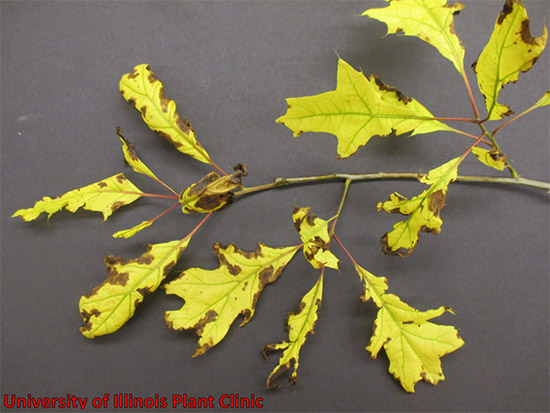Issue 8, June 15, 2015
Chlorosis of Woody Plants
Chlorosis is a yellowing of leaves that should normally be green. This is due to a lack of chlorophyll, causing the tissue to lose its bright green color. Usually the veins will stay a dark green while the leaf tissue turns lime green, then in severe cases, yellow. Necrotic (dead) areas may appear if the chlorosis continues without being treated.
Pin oaks are especially prone to chlorosis, though we often see it affecting sweetgum, maples (especially red and silver) and birch. Chlorosis can be caused by a number of different factors, including poor soil drainage, damaged or compacted roots, and nutrient deficiencies. The most common problem seen across the state is an induced nutrient deficiency, caused by the soil being too alkaline (basic). Environmental conditions such as drought, heavy clay soils, and waterlogged soils can worsen the symptoms.

Maple with symptoms of chlorosis. Note the lime green color of the leaf tissue and the dark green veins.
Iron, and to a lesser extent manganese and zinc, deficiencies are common causes of chlorosis. In some cases the element may be missing in the soil. Usually, the element is present but unavailable to the plant due to the soil pH. A pH of 7 is neutral; above that is alkaline (basic) and below that is acidic. Soils with high pH bind certain elements, including iron and manganese, making them unavailable for the plant to take up through the roots. Illinois soils are often alkaline. While each plant species has their own preferred range of soil pH, most of our woody trees like a pH a little below neutral, often in the 6.3 to 6.7 range.
Management for chlorosis involves determining what element is missing, then trying to alleviate the cause of the deficiency. Generally, an iron deficiency causes the most intense symptoms on the newest leaves, while manganese and zinc deficiencies affect the older leaves the most. A soil test can be very helpful, both to identify if any major macro- and micronutrients that may be missing, and to check the pH. If the pH is too high, the soil can be amended to acidify it and reduce the pH.
Soil pH can be amended by digging holes 12 to 15 inches deep at 2 to 3 foot intervals around the base of the tree and under the canopy, then filling the holes with sulfur or injecting them with chelated iron or manganese. The soil injections act faster than the sulfur additions, though they may not have as long-term of an affect. Soil treatments are done best when the soil is moist and the tree is actively growing new leaves in April, May, and early June.
Trunk injections can be used, though by piercing through the plant's bark the tree is opened to infection or pest issues. Foliar treatments may be recommended, based on the severity of the chlorosis. Because foliar treatments only affect the current growth, they are usually not used unless the tree is suffering major injury. Foliar treatments are a short-term, quick fix, but will not solve the problem in the long run.

Pin oak with severe chlorosis. Note the yellow leaf tissue, darker veins, and necrotic dieback along the leaf margins. This tree should be treated with a foliar application to quickly reduce stress on the tree, coupled with soil amendments to prevent reoccurrence in the future.
In addition to amending the soil, trees that are recovering from or at risk for chlorosis should be maintained in a manner that will reduce potential tree stress. Watering during dry periods lasting more than 2 weeks, mulching the base of the tree lightly, pruning out dead wood, and scouting for and responding to pest issues will improve tree vitality and help the tree recover from injuries. (Diane Plewa)
Author:
Diane Plewa